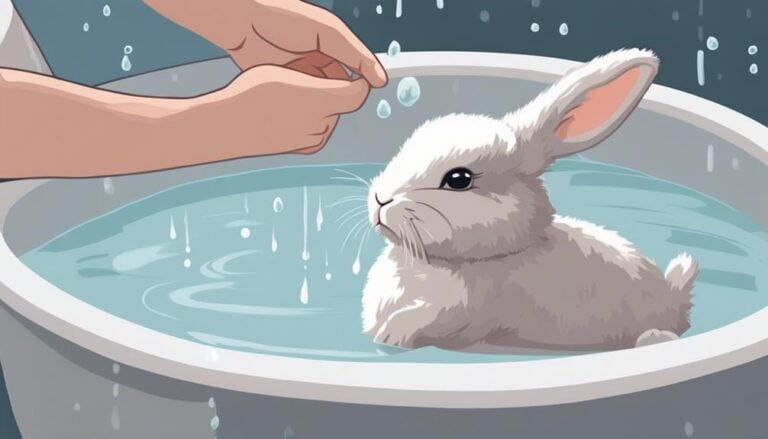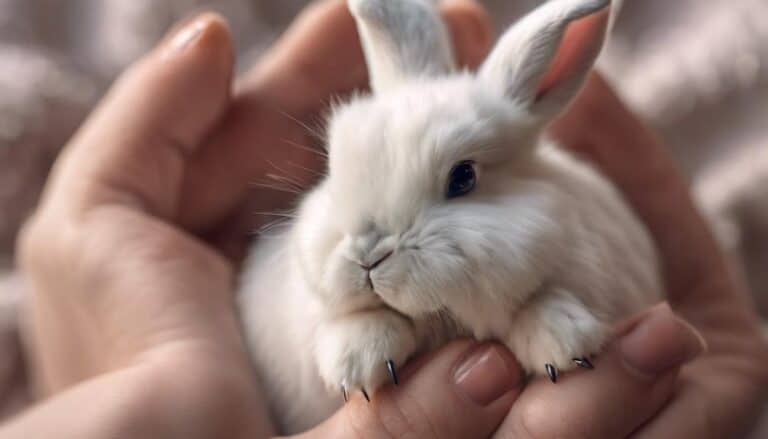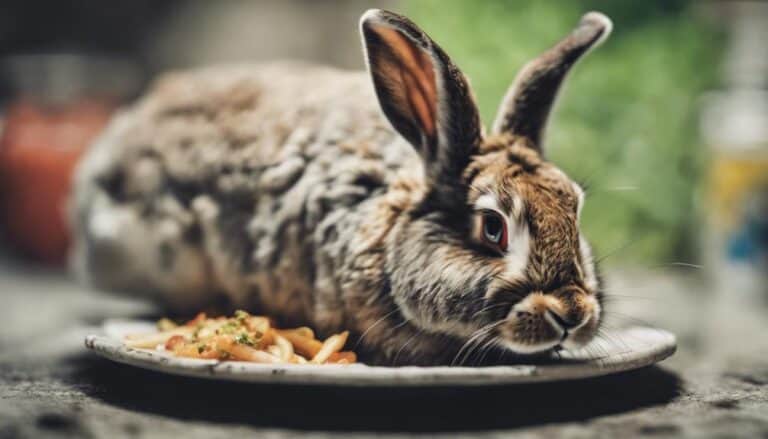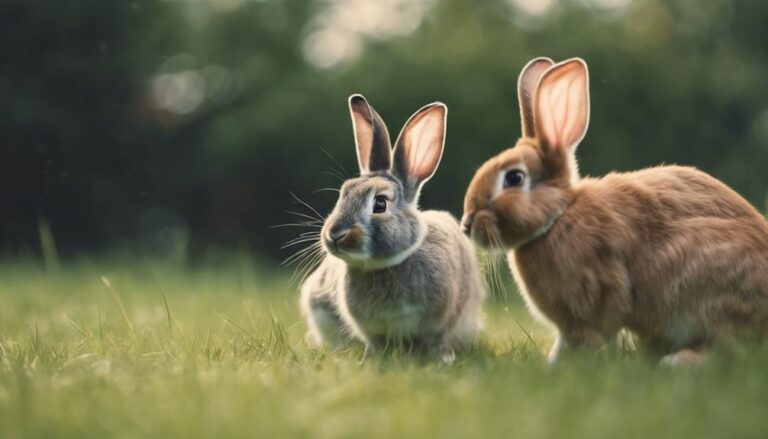So, you're wondering if taking care of a rabbit is similar to taking care of pet mice?
When it comes down to it, rabbits and mice have some pretty different needs.
From where they live to what they eat, these pets require some specific care that sets them apart.
Sure, there might be some similarities, but once you get into the nitty-gritty, you'll find a lot of differences that you need to pay attention to.
Contents
- 1 Key Takeaways
- 2 Rabbit Vs. Mouse Care Overview
- 3 Housing and Exercise Requirements
- 4 Dietary Needs and Differences
- 5 Social Behavior and Interaction
- 6 Grooming and Health Care Variances
- 7 Training and Handling Contrasts
- 8 Cost of Ownership Comparison
- 9 Space and Environment Considerations
- 10 Lifespan and Long-Term Commitment
- 11 Conclusion: Rabbit and Mouse Care Distinctions
- 12 Conclusion
Key Takeaways
So, you're wondering if caring for a rabbit is similar to caring for pet mice? Well, let's break it down.
First off, rabbits need way more space, exercise, and social interaction than pet mice. They're not happy just sitting around in a small cage all day. They need room to move around and stretch their legs.
When it comes to food, rabbits and mice have different dietary needs too. Rabbits need a high-fiber diet that's rich in hay and veggies, whereas mice do better on a balanced mix of seeds and grains.
Rabbits are also super social animals that thrive on companionship. They love having friends, whether it’s another rabbit or even a human. Mice, on the other hand, are pretty solitary creatures and don’t need much social interaction. This difference in social needs impacts how these animals interact with their environment and each other. For example, many bunny owners often wonder, “can cats and rabbits coexist? ” While some cats may have a strong prey drive and view rabbits as potential food, others can learn to live harmoniously with them, provided they are introduced carefully and monitored closely. Ultimately, fostering a safe and respectful environment can lead to peaceful cohabitation.
Taking care of a rabbit also requires more effort when it comes to grooming and health care. They need regular check-ups with the vet, and you need to keep an eye out for any health issues. Mice, being smaller and hardier, don't need as much maintenance in this department.
Lastly, owning a rabbit is definitely more costly than owning pet mice. The initial setup costs are higher, and you'll need to budget for annual expenses like food, vet bills, and supplies. So, while both pets can be fun to have around, they definitely have different needs and requirements.
Rabbit Vs. Mouse Care Overview
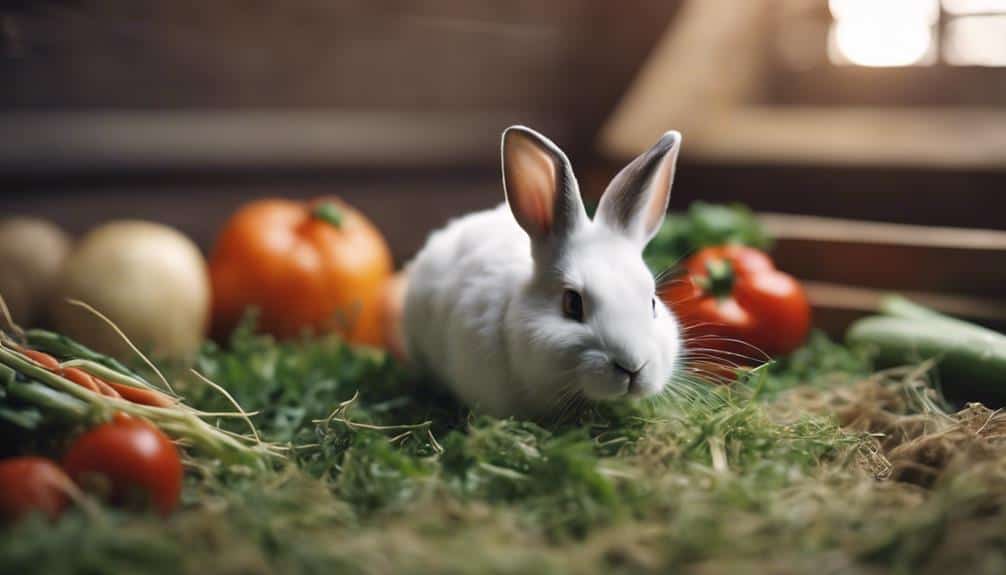
When it comes to caring for rabbits and pet mice, there are some key differences to consider.
Rabbits need a lot of space to move around, so their living environment should be pretty spacious. They also need a special diet that's high in fiber, which means lots of hay, grass, and veggies.
In contrast, mice are happy in smaller enclosures and their dietary needs are much simpler. They can survive on commercial pellets and the occasional treat.
One big difference between the two is that rabbits are super social and need daily interaction and exercise outside of their enclosures. They need at least 3-4 square feet of floor space per rabbit to move around comfortably.
Mice, on the other hand, are more solitary and can entertain themselves within their cages, so they don't need as much space to roam.
Understanding these differences in care requirements is vital to giving your rabbit or mouse a healthy and fulfilling life.
Housing and Exercise Requirements
When it comes to housing and exercise, rabbits and pet mice have very different needs.
Rabbits need a lot more floor space than pet mice. They also require more exercise and specific conditions in their environment.
For example, rabbits need a lot of room to move around and stretch their legs, whereas pet mice are happy with smaller spaces.
It's really important to understand these differences so you can give your small animal friends the best possible care.
If you don't provide what they need, it can lead to health problems and stress.
Rabbit Housing Needs
Housing your rabbit requires a big, escape-proof space that lets your rabbit move around and explore freely. Rabbits need room to roam, exercise, and do what comes naturally to them.
A good rule of thumb is to give your single pet rabbit at least 2x2x4 feet of space to hop around, stretch out, and explore comfortably. You'll also want to set up a special area within that space with the essentials, like a litter box, water bowl, toys, and food.
Exercise pens can be a great way to create a safe enclosure for your rabbit. Just make sure the pen is big enough for your rabbit to move around in. The enclosure should also be tall – at least 2 feet high – so your rabbit can jump up and stand on its hind legs.
To keep your rabbit safe, you'll need to bunny-proof the environment. That means securing heavy objects, blocking off any hazardous areas, and removing potential dangers. By doing this, you can create a safe and stimulating living space for your pet rabbit.
Rabbit Exercise Requirements
Providing enough space for your rabbit to exercise is crucial for their physical and mental health. They need at least 2-3 hours outside of their cage every day to stay healthy and happy.
One way to meet this requirement is to bunny-proof a room or use an exercise pen. This will give your rabbit the freedom to stretch, jump, and move around as they please.
Their cage or enclosure should be at least 2x4x4 feet in size to give them enough room to exercise.
It's also important to create a large, escape-proof area for your rabbit to play in. Fill it with toys, tunnels, and hiding spots to keep them stimulated and encouraged to play.
Rabbits are most active at dawn and dusk, so try to schedule exercise and playtime during these periods to help them fulfill their natural instincts.
Mouse Housing Contrasts
When it comes to providing a comfortable home for your pet, it's essential to understand the differences between mice and rabbits. Rabbits need a lot of space to move around and jump, so they require large, escape-proof areas or exercise pens. Mice, on the other hand, are happy in smaller cages with multi-levels, tubes, and tunnels to explore.
One key difference is the type of flooring they need. Mice are fine with solid-bottom cages, but rabbits need wire mesh floors to prevent health issues like pododermatitis.
When deciding where to place their cages, you should consider the animals' natural habits. Mice are nocturnal, so they prefer quiet, dark areas. Rabbits are crepuscular, which means they're most active at dawn and dusk, and they thrive in areas with moderate to high levels of activity.
Temperature is also crucial. Mice are sensitive to extreme temperatures and need a range of 68-78°F. Rabbits can tolerate a wider range of 60-75°F. By understanding these housing differences, you can ensure your small furry friends live happy and healthy lives.
Dietary Needs and Differences
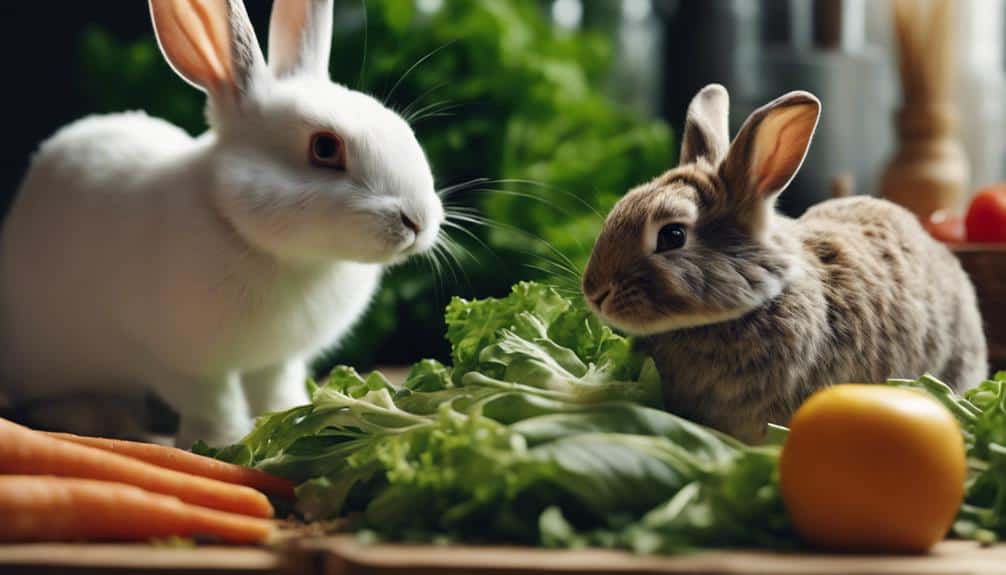
When it comes to taking care of a rabbit versus pet mice, you need to understand their dietary needs and differences.
Rabbits are herbivores, which means they need a diet high in fiber from hay and fresh vegetables.
On the other hand, pet mice are omnivores, so they need a mix of seeds, grains, fruits, and vegetables.
It's super important to pay attention to their feeding habits and provide the right nutritional requirements.
This is essential for keeping both rabbits and pet mice healthy and happy.
Feeding Habits
So you want to make sure your rabbit or pet mice stay healthy and happy, right? Well, the key to doing that is understanding their unique dietary needs and differences. Rabbits, for instance, are herbivores, which means they need a high-fiber diet that's mostly made up of grass hay and veggies. Their digestive system is specially designed to break down plant material, so they need a diet that's rich in fiber.
On the other hand, mice are omnivores, which means they can eat a wide variety of foods including seeds, grains, and even insects. They have a more generalist digestive system that can adapt to different food sources.
Here's a breakdown of the main differences in their feeding habits:
| Aspect | Rabbits | Pet Mice |
|---|---|---|
| Diet Type | High-fiber diet | Omnivorous diet |
| Main Food Source | Grass hay, vegetables | Seeds, grains, insects |
| Digestive System | Specialized for plant material digestion | Generalist, adaptable to various food sources |
Nutritional Requirements
Rabbits need a diet that's really high in fiber. They're herbivores, which means they only eat plants, and they need a lot of hay, grass, and veggies to keep their digestive system running smoothly. In fact, they need a constant supply of fresh hay because their digestive system is specially designed to break down plant material and extract nutrients efficiently.
Unlike mice, rabbits have a unique digestive system that's perfect for processing plant material. They don't need a lot of protein in their diet, but they do need a lot of fiber. This is the opposite of mice, who need a more balanced ratio of protein to fiber.
Social Behavior and Interaction
Rabbits and pet mice are two popular small animals that people keep as pets, but they have very different social behaviors and interactions. This means we need to care for them in different ways.
Rabbits are extremely social animals that love the company of others. They thrive when they're around their friends and family. On the other hand, mice are also social, but they can be aggressive towards each other.
Here's a breakdown of their social behaviors:
| Aspect | Rabbits | Pet Mice |
|---|---|---|
| Social Structure | Rabbits are very social and enjoy living in pairs. | Pet mice live in groups but can show aggression within them. |
| Communication | Rabbits communicate through body language and sounds. | Pet mice use vocalizations and scent marking for communication. |
| Playfulness | Rabbits are playful and enjoy toys and interaction. | Pet mice also engage in playful behaviors within their group. |
Understanding these differences is crucial if you want to give your rabbits and mice the best possible care. By knowing how they interact with each other, you can create an environment that meets their social needs and helps them thrive.
Grooming and Health Care Variances
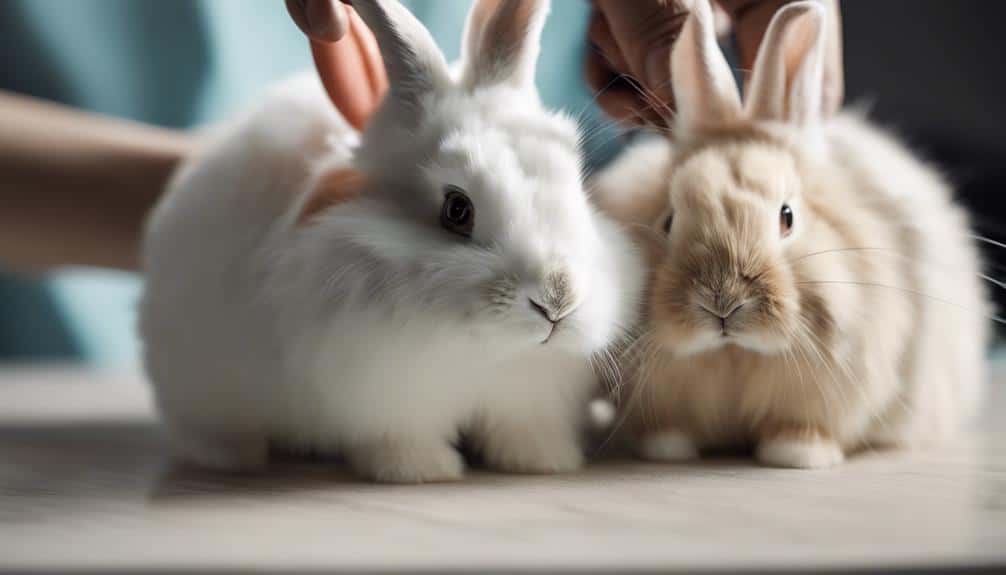
So, you're thinking of getting a pet, and you're deciding between a rabbit and a mouse.
One big difference to consider is how much time and effort you'll need to put into grooming and health care.
Rabbits, for example, need regular nail trimming, grooming, and dental check-ups. If you don't do these things, they can develop some serious health problems, like hairballs, digestive issues, and respiratory infections.
It's a lot of work, but it's necessary to keep them healthy and happy.
Mice, on the other hand, are a lot easier to care for when it comes to grooming and health.
They don't need much grooming at all, and they're less likely to have dental and respiratory problems.
That means their health care is pretty straightforward compared to rabbits.
Grooming Requirements Comparison
When it comes to grooming, rabbits and pet mice have different needs. To keep them healthy and clean, you'll need to follow distinct care routines.
Rabbits are super particular about cleanliness. They use their tongues and teeth to groom themselves, making sure they smell fresh. Mice, on the other hand, are also clean animals, but their grooming process is simpler.
Rabbits need regular nail trimming to prevent their nails from getting too long. You can do this yourself if you're experienced, or have a vet do it. Mice, however, don't need their nails trimmed.
Rabbits shed their fur, especially during seasonal changes, and need regular brushing to prevent hairballs. Mice, on the other hand, have a shorter, smoother coat that requires less maintenance.
Rabbits are prone to dental problems if their teeth aren't kept in check, so proper grooming is essential to prevent issues. Mice, on the other hand, are more susceptible to respiratory problems and tumors if their environment lacks good ventilation.
Health Care Differences
When it comes to keeping your pet rabbits and mice healthy, regular veterinary check-ups are crucial. But did you know that rabbits need a lot more care than mice?
For starters, rabbits require regular nail trimming, dental care, and close monitoring for signs of illness. Rabbits are more likely to get sick with things like respiratory infections, dental problems, and gastrointestinal stasis, which means they need to see the vet more often.
Mice, on the other hand, are pretty low-maintenance when it comes to grooming and health care. They don't get sick as often and don't need to go to the vet as much.
Another key difference is that rabbits need a super clean living environment to stay healthy. Rabbits have a more complex digestive system, which means they need a high-fiber diet to prevent digestive problems.
Mice, while not exactly thrilled about dirty conditions, can tolerate them a bit more. But don't get it wrong – mice still need their cages cleaned regularly! Mice do just fine on commercial mouse food.
Understanding these differences in health care needs is vital if you want to take good care of your pet rabbits and mice.
Preventive Care Needs
So you want to keep your pet rabbits and mice healthy and happy? To do that, you need to understand their different preventive care needs, especially when it comes to grooming and health care.
First, let's talk about nail care. Rabbits need their nails trimmed regularly, but mice and rats don't because they naturally wear them down.
Next up is dental care. Rabbits need their teeth trimmed regularly to prevent overgrowth, but mice and rats don't need this.
Grooming is also important. Rabbits can get hairballs and digestive issues if they're not groomed regularly, but mice and rats are less likely to have these problems.
Another key area is ear and eye care. Rabbits need their ears and eyes cleaned regularly to prevent infections, which is less of a concern for mice and rats.
Training and Handling Contrasts
When you're comparing the training and handling needs of rabbits and pet mice, you need to consider their unique behavioral and physical characteristics.
Rabbits are super social and thrive on interaction and attention. They need daily socialization and gentle handling to prevent boredom and stress. You can even train them to use a litter box and perform tricks, but you've got to be patient and careful when handling them because of their delicate bone structure. Rabbits show affection in their own way, like by licking and nuzzling, and they really enjoy spending time with humans.
On the other hand, pet mice are more observational and less interactive, so they don't need as much human interaction. Mice are fragile animals, so they need gentle handling due to their small size and delicate nature. While rabbits may need specialized training and handling techniques because of their strength and size, mice require a more cautious approach.
Understanding these differences is crucial for providing the right care to these distinct pets.
Cost of Ownership Comparison
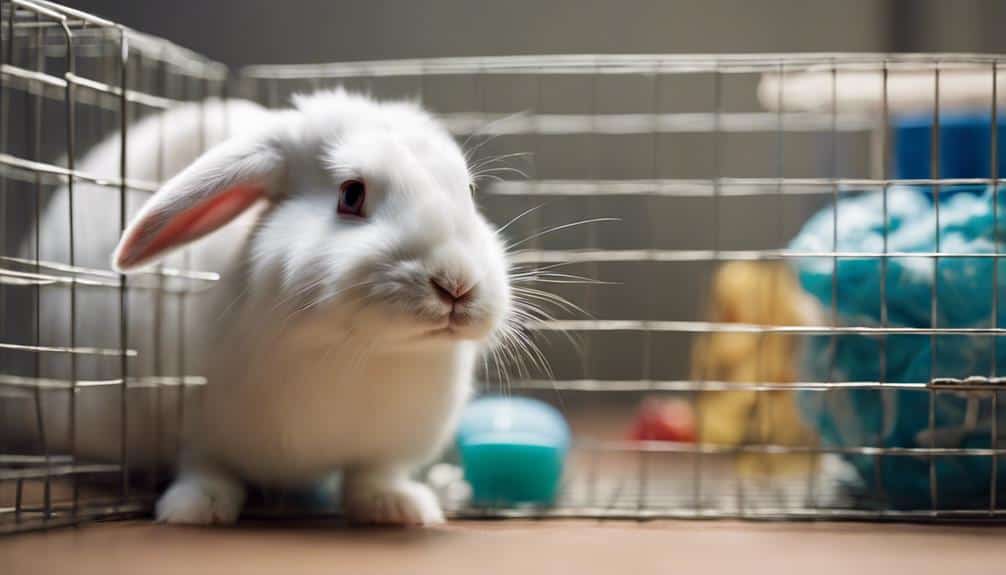
So you're thinking of getting a pet, and you're trying to decide between a rabbit and a mouse?
One thing to consider is the cost of owning each of these adorable critters.
First, there's the initial setup. Rabbits need more space and equipment, which means you'll have to shell out more money upfront compared to mice.
When it comes to annual expenses, rabbits are going to cost you around $1,000 to $1,500 per year. Mice, on the other hand, will set you back around $200 to $300 per year.
Veterinary care is another expense to consider. Rabbits need regular check-ups, which can cost $100 to $150 per visit. Mice are less prone to health issues, so you'll save on vet bills.
Finally, there's the long-term cost to think about. Rabbits can live for up to 10 years, so you'll need to budget for extended care and supplies. Mice, on the other hand, typically only live for 1-2 years.
Considering all these factors, owning a rabbit is going to be more expensive than owning a mouse. So, make sure you're prepared for these financial commitments before making a decision.
Space and Environment Considerations
When it comes to creating a comfortable and happy home for your rabbits and mice, you've got to think about the space and environment they need.
Rabbits, for instance, need a lot of room to roam, exercise, and play. They require a minimum of 12 square feet of living space, either in a bunny-proof room or an exercise pen.
This space should include the essentials like a litter box, water bowl, toys, and food dishes. But that's not all – rabbits are super energetic, so they need regular time outside of their enclosure to run and jump around.
Mice, on the other hand, can thrive in smaller enclosures compared to rabbits. What they need is a well-ventilated habitat with hiding places and toys to feel safe and entertained.
Unlike rabbits, mice are generally happy to stay within their enclosures, making them easier to contain.
When it comes down to it, ensuring a safe and stable environment is crucial for both rabbits and mice. The key difference is that rabbits need more space and attention due to their larger size and higher energy levels.
Lifespan and Long-Term Commitment
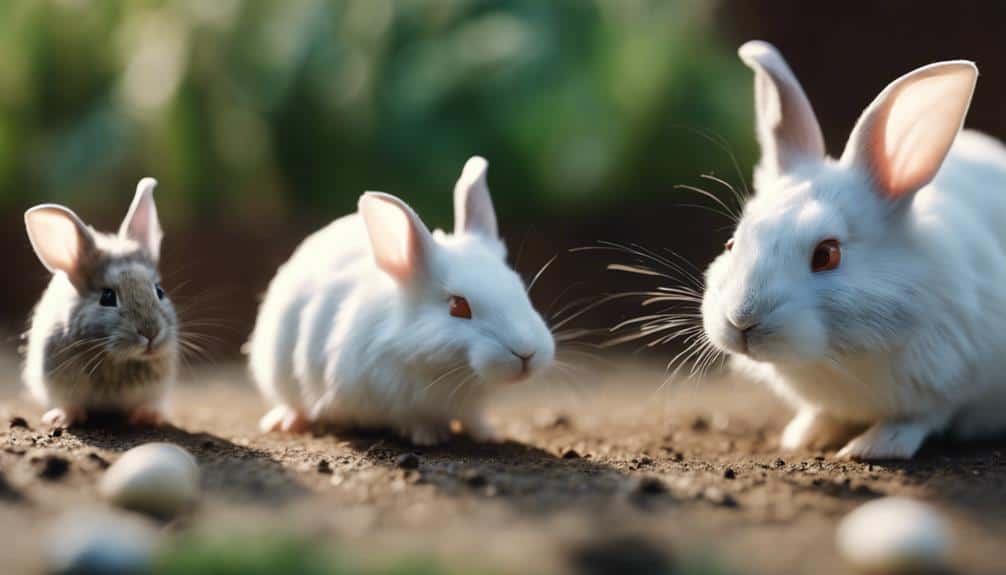
So, you're thinking about getting a pet, and you're trying to decide between rabbits and mice?
One big difference between the two is how long they live and how much time and effort you'll need to put into caring for them.
First, let's talk about lifespan. Rabbits can live for up to 10 years, while mice typically only live for 1-2 years. That's a big difference! With a rabbit, you're making a commitment to care for it for a decade, while with a mouse, you're looking at a much shorter timeline.
When you own a rabbit, you're committing to providing a stable home, regular vet visits, and a consistent diet for a long time. This means you'll need to think about things like frequent vet check-ups and potential health issues like dental problems and respiratory infections. Rabbits need more extensive care because they live longer, and you'll need to be prepared to deal with any health issues that come up over the years.
The longer lifespan of rabbits also means you'll need to be prepared for a longer and more in-depth care routine to keep them healthy and happy. This is important to think about before you bring a rabbit into your home, because it's a big responsibility.
Conclusion: Rabbit and Mouse Care Distinctions
When it comes to caring for rabbits and mice, it's crucial to understand their unique needs and characteristics.
For starters, rabbits need a lot more space to move around compared to mice. They require a minimum of 3-4 hops in all directions to thrive, which means their living quarters need to be pretty spacious.
Their digestive system is also more complex, so they need a high-fiber diet rich in hay and vegetables. Mice, on the other hand, can get by on a simpler diet of commercial pellets.
Rabbits are also more social creatures, needing daily interaction and socialization to prevent boredom and stress.
Mice, by contrast, are generally content with less human contact. Another key difference is their lifespan. Rabbits can live for 8-12 years on average, while mice typically live for 1-2 years.
Caretakers of rabbits should be prepared for more veterinary care, including regular check-ups and specialized attention, due to their unique health issues.
Mice, on the other hand, are generally hardier and require less frequent veterinary visits.
Understanding these distinctions is vital for providing ideal care to rabbits and mice.
Conclusion
So, you're wondering if caring for a rabbit is similar to caring for pet mice? Well, the short answer is no, it's not.
First of all, rabbits can live up to 10 years or more, while mice typically have a much shorter lifespan of 1-3 years. That's a big difference.
Understanding the unique needs and differences between these two pets is crucial if you want to provide them with the proper care and ensure their health and happiness.
When it comes to choosing a new pet, it's essential to do your research and pick the right one for your lifestyle.

